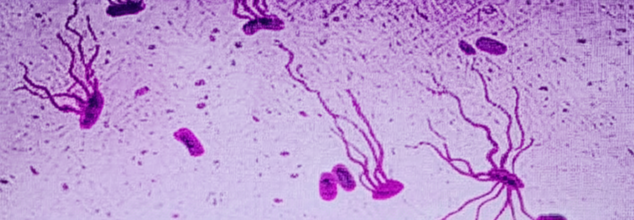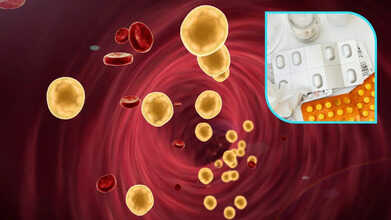- Health Conditions A-Z
- Health & Wellness
- Nutrition
- Fitness
- Health News
- Ayurveda
- Videos
- Medicine A-Z
- Parenting
This Age-Old Killer Is Spreading Fast, Why Super Typhoid Isn’t Just A ‘Poor Country’ Problem Anymore

Representational
Typhoid fever is not the kind of illness most people in developed nations worry about. It's often written off as a disease of the past—something that plagued ancient societies before clean water systems and antibiotics. But here’s the thing: typhoid never went away. And now, it's evolving into something much more dangerous—something even modern medicine might not be able to stop.
A large genomic study published in The Lancet Microbe in 2022 has sounded the alarm. The bacterium responsible for typhoid, Salmonella enterica serovar Typhi (or S. Typhi), is rapidly acquiring resistance to nearly all antibiotics used to treat it. More disturbingly, strains resistant to multiple drug classes are spreading beyond their traditional strongholds in South Asia and appearing across continents—including in the United States, United Kingdom, and Canada.
This is no longer a regional concern. It’s a global one.
What is Super Typhoid?
The study involved sequencing over 3,400 S. Typhi strains collected between 2014 and 2019 from patients in India, Pakistan, Nepal, and Bangladesh. The results were stark. Not only were extensively drug-resistant (XDR) strains of typhoid rising rapidly, but they were also outcompeting and replacing less resistant versions.
Also Read: From ADHD To Burnout: Why Modern Life Is Making You Sleepless, Anxious And Insomniac
XDR typhoid strains are already immune to several older antibiotics—ampicillin, chloramphenicol, and trimethoprim/sulfamethoxazole. But here’s where it gets worse: many are now developing resistance to newer and more potent drugs like fluoroquinolones and third-generation cephalosporins, which until recently were mainstays of typhoid treatment.
Even the last reliable oral antibiotic—azithromycin—is showing signs of failure. The study found emerging mutations that could potentially render azithromycin ineffective. These haven’t yet converged with XDR strains, but scientists warn that it’s only a matter of time. If that happens, oral treatment options could become entirely obsolete.
For now, South Asia remains the epicenter of the crisis, accounting for about 70% of the global typhoid burden. But this doesn’t mean the threat is contained.
Researchers tracked nearly 200 instances of international transmission since the 1990s, most involving travel or migration. Typhoid "superbugs" have been detected in Southeast Asia, East and Southern Africa, and in wealthy nations where the disease was thought to be virtually eradicated.
“The speed at which highly-resistant strains of S. Typhi have emerged and spread is a real cause for concern,” said Dr. Jason Andrews, an infectious disease specialist at Stanford University who co-authored the study.
Why Is Treatment Is Failing?
If antibiotics are failing, what’s next? For starters, prevention. Experts say the most immediate and scalable solution lies in typhoid conjugate vaccines (TCVs). These vaccines offer strong, long-lasting protection and are safe for children as young as six months old. But access is patchy.
Pakistan became the first country to introduce TCV into its national immunization program in 2019—an urgent response to the first major outbreak of XDR typhoid that hit its population. Since then, the move has become a case study in how vaccination can cut off the disease at its roots.
India, Bangladesh, and Nepal have followed suit with pilot programs and localized rollouts, but global coverage remains far too low. Meanwhile, high-income countries have not prioritized TCV access at all, largely because typhoid isn’t seen as a domestic threat.
Antibiotic Resistance Crisis at Large
This typhoid crisis isn’t an isolated story. It’s part of a larger, systemic problem: antibiotic resistance is now one of the top global causes of death. A 2019 study published in The Lancet estimated that antimicrobial resistance was directly responsible for 1.27 million deaths worldwide, surpassing HIV/AIDS and malaria.
Typhoid is just the latest face of that threat. If azithromycin fails, intravenous treatments will be the only remaining option. This is not sustainable for low-resource settings, where typhoid is most rampant.
And as the S. Typhi genome continues to adapt, the search for novel antibiotics becomes more urgent but the global antibiotic pipeline is worryingly dry. Very few new drugs are being developed, and those that are rarely target neglected tropical diseases like typhoid.
How Globalization Makes It Everyone’s Problem?
COVID-19 reminded us how quickly a localized health threat can go global. Typhoid is no different. The bacteria travel with people—through tourism, immigration, and international trade.
The difference is: we already have tools to stop this. TCVs work. Better sanitation and access to clean water help. Public health messaging and travel guidelines can make a difference. But we’re not moving fast enough.
A recent Indian study estimated that vaccinating children in urban areas could reduce typhoid cases and deaths by up to 36 percent. That’s a significant dent—especially when combined with infrastructure upgrades and careful antibiotic stewardship.
What Happens If We Do Nothing?
If left unchecked, drug-resistant typhoid could become nearly impossible to treat in outpatient settings. That means more hospitalizations, more strain on health systems, more deaths—particularly among children in developing nations.
With around 11 million cases of typhoid annually, even a small increase in resistance could tip the balance into a major health crisis.
And if XDR strains gain resistance to azithromycin, we will be left with zero effective oral drugs, none. The path forward is clear—and urgent. Here’s what needs to happen:
- Expand global access to typhoid conjugate vaccines, especially in endemic regions.
- Invest in next-generation antibiotics that target typhoid and other neglected infections.
- Implement stricter regulations on antibiotic use in agriculture and medicine.
- Strengthen global surveillance systems to detect resistant strains early and contain outbreaks.
- Raise awareness that typhoid is not just a problem for the developing world.
Antibiotic resistance isn’t science fiction. It’s a biological reality. And typhoid is just one example of how quickly things can unravel when we underestimate an ancient enemy.
We can still turn the tide but only if we act with urgency and coordination. The warning signs are flashing red. Typhoid isn’t gone. It’s evolving. And this time, it may be deadlier than ever.
Delhi Pollution Drops From Very Poor To Poor, Experts Say Relief Is Temporary

Credits: PTI
Delhi woke up to a slightly lower levels of AQI on Sunday Morning, November 30, as city's AQI dropped to 269 at 7am down from 305, which was recorded at 4pm on Saturday. This now falls under the "poor" category. However, experts say that the relief is temporary.
Many health experts and those who have studied the impact of pollution on humans have pointed out that anything above 300 is harmful to humans. These harms are not just limited to respiratory illnesses, and to lungs, causing lung cancers, but can also be the reason why obesity is on the rise.
Can Air Pollution Cause Obesity?
As per a 2021 study titled Effect of Air Pollution on Obesity in Children: A systematic Review and Meta-Analysis, there is a connection between air pollution and weight gain through biological behavioral mechanism. The major pollutants causing obesity are nitrous oxides, nitrogen dioxide, ozone, and particulate matter.
These could lead to systematic inflammation and metabolic disturbances, which can lead to weight gain and obesity. The study mentions that fine particulate matter [PM2.5], when it enters our body, it influences the metabolism rates.
The 2021 study also revealed that increase in air pollution, and road traffic noise was also associated with childhood obesity.
Also Read: 'Facing Breathing Issues After Morning Walk' Says CJI Surya Kant As Delhi's Toxic Air Worsens
Another 2011 study titled The influence of air pollution on cardiovascular and pulmonary function and exercise capacity: Canadian Health Measures Survey (CHMS), found that air pollutants may indirectly impact body weight by raising the risk of chronic conditions like blood pressure, heart diseases or lung diseases. "Exposure to higher concentrations of air pollution was associated with higher resting blood pressure and lower ventilatory function. Ozone was associated with reduced exercise capacity," researchers of the study wrote.
The latest study published in 2024 titled The association between air pollution and obesity: an umbrella review of meta-analyses and systematic reviews, found that air pollution can impact metabolic function by influencing inflammation in fat tissue. It leads to an increase in oxidative stress and alters one's dietary habits.
Pollution And Women's Health
This does not end here, air pollution could also negatively impact women. As Dr Anuradha Kapur, Principal Director (Obstetrics & Gynaecology) and Head of Unit, Max Smart Super Speciality Hospital, Saket says, "Environmental pollutants, such as pesticides and microplastics, can affect reproductive health and hormone regulation, potentially impacting menstrual cycles."
Dr Sonam Simpatwar, Gynaecologist with a diploma in reproductive medicine, practising at Central Railway Hospital, Mumbai further explained how pollutants impact women's health:
Endocrine Disruptors: Chemicals found in pollution, plastics, and pesticides can mimic or interfere with hormones, potentially affecting menstrual cycles.
Climate Change: Rising temperatures, extreme weather events, and changes in water quality can impact food production, nutrition, and overall health, which can indirectly affect menstrual health.
Stress: Environmental stressors, such as pollution and climate change, can lead to increased stress, which is known to influence menstrual cycles.
"It's important to note that these are potential factors, and more research is needed to fully understand their impact on menstrual health," she said.
Enlicitide: New Drug Cuts LDL Cholesterol By 60 Percent, Offers Fresh Hope For Heart Health

Credits: Canva
High levels of low-density lipoprotein cholesterol (LDL-C), commonly called "bad" cholesterol, continue to be a leading modifiable risk factor for atherosclerotic cardiovascular disease (ASCVD) worldwide. While statins and other cholesterol-lowering medications have significantly improved treatment, many patients still do not reach the LDL-C targets recommended by guidelines.
However, a new potential solution has emerged. The experimental daily oral drug called enlicitide, part of the PCSK9 inhibitor class, demonstrated in a key Phase 3 study (CORALreef Lipids) a reduction in LDL-C of about 55.8% at 24 weeks, with post-hoc analysis suggesting reductions up to 59.7% compared to a placebo.
Statins Vs Enlicitide
Statins are the standard first-line treatment for high LDL-C and have strong evidence for lowering the risk of cardiovascular events. Yet, many patients either cannot tolerate high doses or still have elevated cholesterol levels. Injectable PCSK9 inhibitors, which are monoclonal antibodies, address this gap and can lower LDL-C by up to 70% but are expensive, require injections, and have limited uptake.
Introducing an oral PCSK9 inhibitor could make powerful LDL-C reduction more accessible. According to trial data, enlicitide may achieve reductions similar to injectable options while being more convenient and potentially more widely available.
Enlicitide: A Potential Breakthrough for "Bad" Cholesterol
The CORALreef Lipids Phase 3 study involved 2,912 adults at risk of or with established ASCVD who were either already on lipid-lowering therapy or unable to take statins. Participants were randomly assigned to receive a daily 20 mg dose of oral enlicitide or a placebo. At 24 weeks, the main analysis showed an average LDL-C reduction of 55.8%, with a post-hoc reanalysis estimating 59.7%. The drug’s safety profile was similar to placebo, with no major safety concerns reported and low rates of discontinuation due to adverse effects.
Enlicitide Implications: What Does This Mean Clinically?
These reductions are substantial, suggesting oral enlicitide could:
- Improve adherence since it eliminates the need for injections
- Increase access, particularly in resource-limited areas
- Provide an alternative for patients intolerant or resistant to statins
In India, where ASCVD prevalence is high and expensive therapies are less accessible, this pill could provide a practical, scalable option alongside diet, exercise, and current statin or ezetimibe treatments.
Enlicitide Caveats: Unanswered Questions To Be Mindful Of
Despite the promising LDL-C reductions, several key issues remain:
- Cardiovascular outcomes: It is not yet confirmed whether enlicitide lowers heart attacks, strokes, or mortality. Current data focus on cholesterol reduction, not clinical endpoints.
- Long-term safety: Data beyond 24 weeks and one year is limited.
- Approval and cost: Enlicitide is still investigational and not available for regular use. Regulatory approvals, like FDA evaluation, will review full data. Its real-world adoption in India will depend on cost and accessibility.
- Patient selection and combination therapy: How enlicitide will be integrated with existing statins, ezetimibe, and lifestyle interventions is still under review. Guidelines may require updating.
- Sub-group efficacy: Will results apply across different ethnicities, comorbidities, and specifically the Indian population? Local data will be important.
The investigational oral pill enlicitide could represent a major advance in cholesterol management. For patients whose LDL-C remains high despite statins, or who cannot tolerate injections, it offers a potent and convenient alternative. Yet, medicine requires caution.
Disclaimer: This content is for general informational purposes only and is not a substitute for professional medical advice. Always consult a doctor or specialist before starting or changing any medication
Taking Gabapentin? NHS Warns These Dangerous Side Effects Need Immediate Medical Attention

Credits: Canva
According to NHS advice, people who use gabapentin may face rare emergencies linked to the medicine. Although it is not officially classed as a painkiller, doctors often prescribe it for nerve pain that follows an injury. It is also used for discomfort caused by shingles or diabetes. The medicine works by interrupting pain signals that move between the brain and spinal cord. Gabapentin is also a common treatment for epilepsy and falls under the group of anticonvulsant drugs. Most people take it as capsules, tablets, or a liquid, usually three times a day.
NHS information notes that the majority of users do not face any side effects. Those who do usually notice only mild and short-lived symptoms.
What Is Gabapentin?
Gabapentin is a prescription drug that belongs to a group of medicines called anticonvulsants. Doctors usually give it to people who have nerve pain or to help manage certain types of seizures in epilepsy. It is sold under names like Neurontin, Gralise, and Horizant, along with widely used generic versions.
What Is Gabapentin Approved For?
Gabapentin is prescribed for a few main purposes:
- It helps prevent and control partial seizures. Adults and children aged three and older who experience partial seizures can take it as part of their treatment plan.
- It also eases nerve pain that can appear after a bout of shingles in adults. Shingles develops years after a person has had chickenpox. The chickenpox virus stays quiet in the dorsal root ganglion, a section of the spinal nerve. In some people, usually during times of heightened stress, the dormant virus becomes active again and causes the painful shingles rash. When the rash settles but the nerve pain remains, the condition is known as postherpetic neuralgia.
- Gabapentin is also approved for people who have moderate to severe primary restless legs syndrome.
- Neurontin and Gralise, the branded forms of gabapentin, are licensed for treating partial seizures and postherpetic neuralgia. Horizant, another branded version called gabapentin enacarbil, is approved for restless legs syndrome and postherpetic neuralgia.
Side Effects Of Gabapentin
There are times when gabapentin may lead to serious reactions that need emergency attention. Mild effects can include an upset stomach, dry mouth, weight gain, or slight memory troubles.
More concerning reactions may involve thoughts of self-harm, unusual muscle pain or weakness, or seeing or hearing things that are not there. Even then, NHS guidance states that these usually require an urgent call to a doctor or 111 rather than ambulance help.
When You Should Call 999 While Taking Gabapentin
Like many medicines, gabapentin can trigger a severe allergic reaction known as anaphylaxis. This can cause several symptoms, such as swelling in the throat or difficulty breathing. The NHS advises calling 999 if you are taking gabapentin and experience any of the following:
- Sudden swelling of the lips, mouth, tongue, or throat
- Fainting and the person cannot be woken
- Lips, skin, or tongue turning blue, pale, or grey
- Trouble breathing or unusually fast breathing
- A tight sensation in the throat or difficulty swallowing
© 2024 Bennett, Coleman & Company Limited

